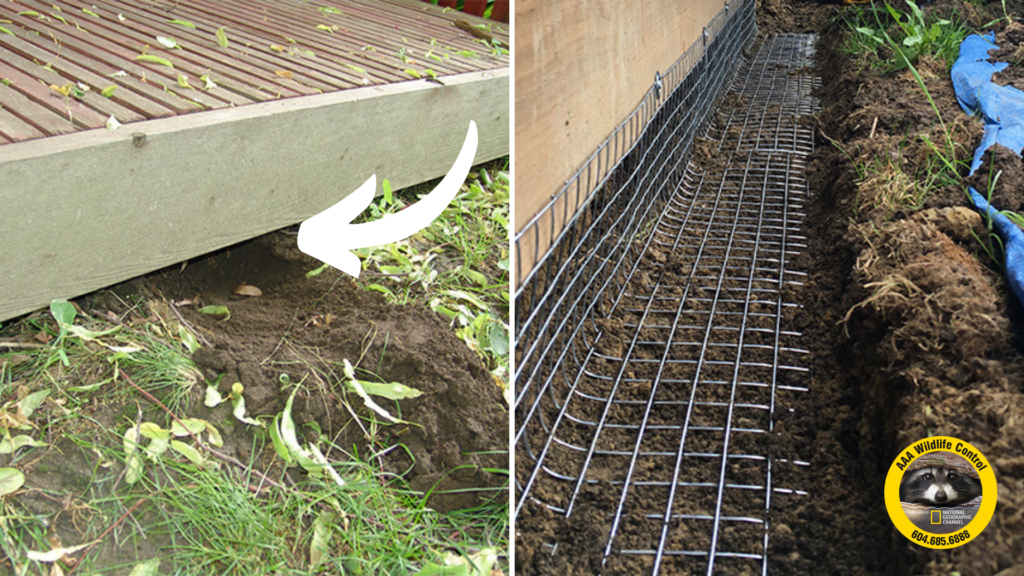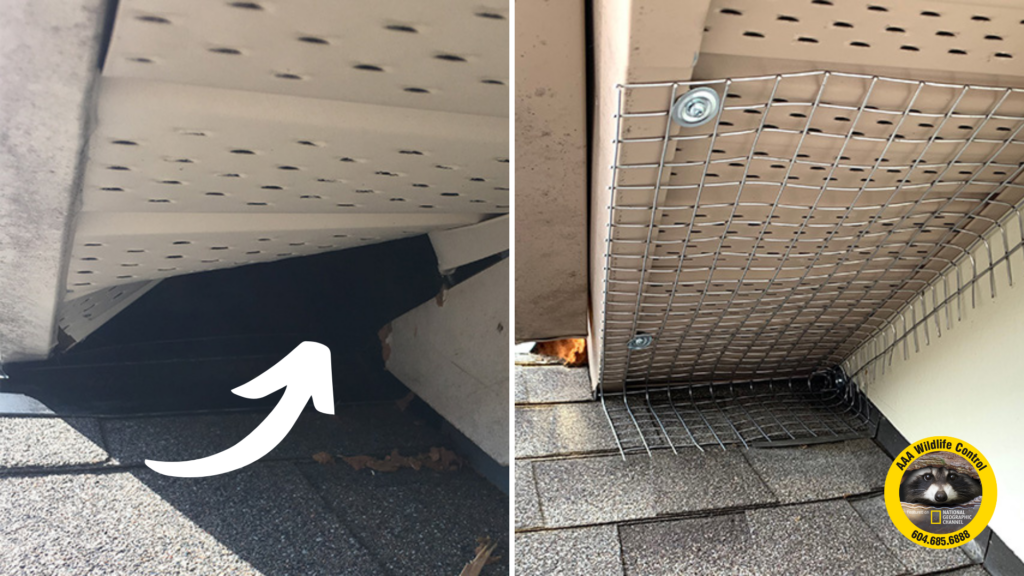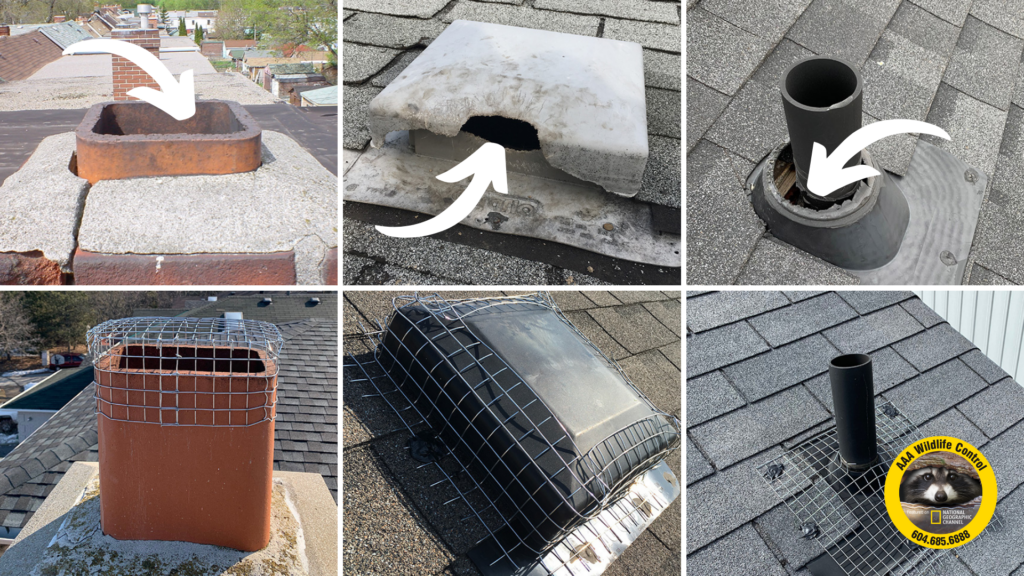DIY “critter check” for your home
You may be surprised where wild animals choose to set up their homes!
Every spring, wildlife rehabilitation centres and wildlife control companies hear a lot of the same call – people finding an unexpected guest or even an entire family making a home in some areas of your home. Although these may seem strange to you, to a wild animal, these areas meet their top 3 criteria for a home:
- Dark
- Quiet
- Safe
Whether you own or rent your home, you can follow our DIY critter check from the ground up, and look for any vulnerabilities.
1. Under decks, porches, building foundation

For animals that aren’t afraid to dig, underneath a shed, deck or porch makes a cozy spot to den.
Check the base where the materials meet the ground. If planned in advance, a concrete base can help prevent animals from digging underneath. Otherwise, you may want to seal those spaces off using heavy-gauge metal mesh. Installed in an L-shape, the metal will prevent animals from digging around the base.
Be careful – if you notice signs of digging or disturbed dirt, that’s a good sign that an animal has already moved in. Don’t seal off an area unless you’re sure there are no animals (including babies) inside. To check, stuff a piece of crumpled up newspaper in the hole and wait 2-3 nights. If the piece of newspaper has moved, that’s a sign that an animal has been using the hole.
In addition to porches and decks, take a walk around the outside of your building to look at the foundation. Rodents can enter holes no bigger than a dime! If your finger can fit in a hole, it’s likely a mouse can too.
Read more on rodent-proofing your home.
2. Dryer vents

Dryers, stoves and bathrooms may have exhaust vents on the side of your home. These make ideal nesting sites for birds, and sometimes even small mammals like squirrels.
The number one sign? Look for grasses, sticks, or straw sticking out from the vent – a good sign that a bird has made a cozy home. You might also notice sounds or odours coming from the vent, or you might see insects in and around the vent.
These vents are usually made from plastic, and not particularly tough. The best way to exclude animals from them is by protecting them with a metal cover. This lets the air vent, but prevents animals from getting in.
3. Trees and branches

Take note of any trees or branches that a crafty raccoon or an acrobatic squirrel could use as a ladder or launchpad on to your roof. The easier it is for them to get up, the more likely they are to move in. If possible, trim back any branches that touch the roof or could be used to climb up. Stay safe when working with heights – call a professional for help if needed.
Ideally, trim branches in the fall to avoid potentially disturbing any nests or spring babies! Learn more about how to stay wildlife-wise during spring cleaning.
4. Soffits

Soffits are plastic or aluminum panels that cover the underside of a roof overhang. They are generally easy to bend out of shape, or only loosely installed. Once pushed aside, animals can get inside roofs and attic spaces.
From the ground or even a rooftop deck, check for intersections where soffits meet the roof or other surfaces. Look for any scratches or gaps in the soffits – a good sign that animal has tried, or has already made their way in. Animals are surprisingly flexible! Even if a hole looks small, animals may still be able to squeeze in.
You can prevent access through the soffits by protecting them with heavy-gauge metal mesh. If time and budget allow, you could also consider replacing them with a more sturdy or secure type.
5. Roof fascia

Wooden fascia is easy enough to chew, or there may be gaps between the roof and the eaves big enough for wild animals to squeeze in.
From the ground or a rooftop deck, look at where the eaves meet the roof. If you see any signs of chewing or scratching, or visible gaps, an animal might be able to get in. Sometimes the shingles will cover the gap, making it hard to see. If you notice any strange sounds or smells coming from your attic, it’s worth investigating!
6. Chimneys, vents and pipes

No ladder? No problem!
Instead of climbing onto the roof, zoom into satellite images of your house using online map tools. If you have a rooftop deck, you might also be able to see these structures from a safe spot there.
A vacant chimney makes a surprisingly good home, but animals like raccoons, birds and squirrels can also fall in by accident and get stuck at the bottom. If your chimney opens directly into the home, you may be surprised when a critter tumbles out! Even if your chimney or fireplace has been renovated, the top may be left open thinking this wouldn’t be a problem. Check to make sure your chimney has a secure metal covering.
Roof vents, plumbing vent mats, and pipes are all potential entry points for wild animals. Vents are often made from plastic or light aluminum and easily chewed or broken by a determined animal. Similarly, the rubber of plumbing vent mats can be easily ripped. If animals fall or climb into the pipe, they could be injured or stuck – plus, this may damage your plumbing system.
Secure these openings in your roof by using sturdy metal coverings and materials. You may need professional help for rooftop work.
What to do if you find a critter
If you find a critter or a family of critters, don’t panic – call an AnimalKind company for help. AnimalKind companies specialize in excluding animals. This means they can encourage the animals to move along, but keep the whole family together to ensure no one gets left behind. Once the animals are out, AnimalKind companies can repair any holes to prevent future break-ins.
Live in an apartment, or rent your home? Ask your landlord, property manager, or strata to hire AnimalKind companies. They may be able to help wildlife-proof your entire building!
If you don’t live in an area with an AnimalKind company, follow our tips for finding a company, or asking them to follow AnimalKind standards.